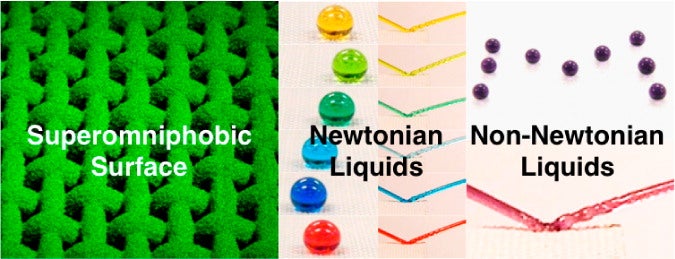Superomniphobic Material Repels Any Liquid You Can Think Of
A new kind of liquid-repelling coating sends any liquid bouncing, rolling, or wicking away.

We’ve seen lots of hydrophobic materials before, but these water- and liquid-repelling materials often work within constraints. Some liquids bounce or wick away, while others–based on properties like viscosity or surface tension, or whether the substance in questions is organic or inorganic–are not affected by the hydrophobic qualities of the material. But a team of University of Michigan materials science is reporting a breakthrough that could have big implications for everything from stain-free clothing to protective surface coatings and chemical resistant protective suits: a superomniphobic coating that is resistant to pretty much any liquid we know of.
The coating is derived from an electrospun coating that is carefully structured in a cross-linked pattern that essentially makes it impervious to attack from any contact angle, and that’s really the critical piece to this. We’ve seen superhydrophobic surfaces before that are extremely adept at repelling high surface tension liquids like water. And we’ve seen what are known as superoleophobic materials that are repellant toward low surface tension liquids.
But superomniphobic surfaces have been more elusive. In laboratory settings they’ve been developed for resistance to Newtonian fluids, but the U. of Michigan teams claim that their material is the first that is truly supermniphobic in the sense that any liquid you throw at it–organic or inorganic, high surface tension or low surface tension, Newtonian or non-Newtonian (repellant to ketchup!)–will bounce or roll off.
Which is pretty crazy. In a paper submitted to the Journal of the American Chemical Society, the team describes dropping aluminum sheets coated in their superomniphobic material in vats of concentrated hydrochloric acid and concentrated sodium hydroxide (that’s a highly caustic metallic base) and anxiously watching absolutely nothing happen. Even when examined microscopically after several minutes of immersion, the aluminum showed no damage.
That, of course, is big news for chemical shielding. Textiles coated in the stuff could make for pretty serious all-purpose hazmat suits, and coatings could be used for everything from corrosion-resistance to drag reduction for maritime vessels.